While my sister and her boyfriend spent the day at Sawgrass Outlet Mall, Michael and I woke up at 6am to start our fishing day. Our first stop was the canal next to the Port Everglades Expressway. A friend of ours suggested this location to catch Spotted Tilapia, Mayan Cichlid and Yellow Belly Cichlid.
As soon as we started fishing, we found some Spotted Tilapia hiding under the dock.
Spotted Tilapia (Tilapia mariae) – new species #3
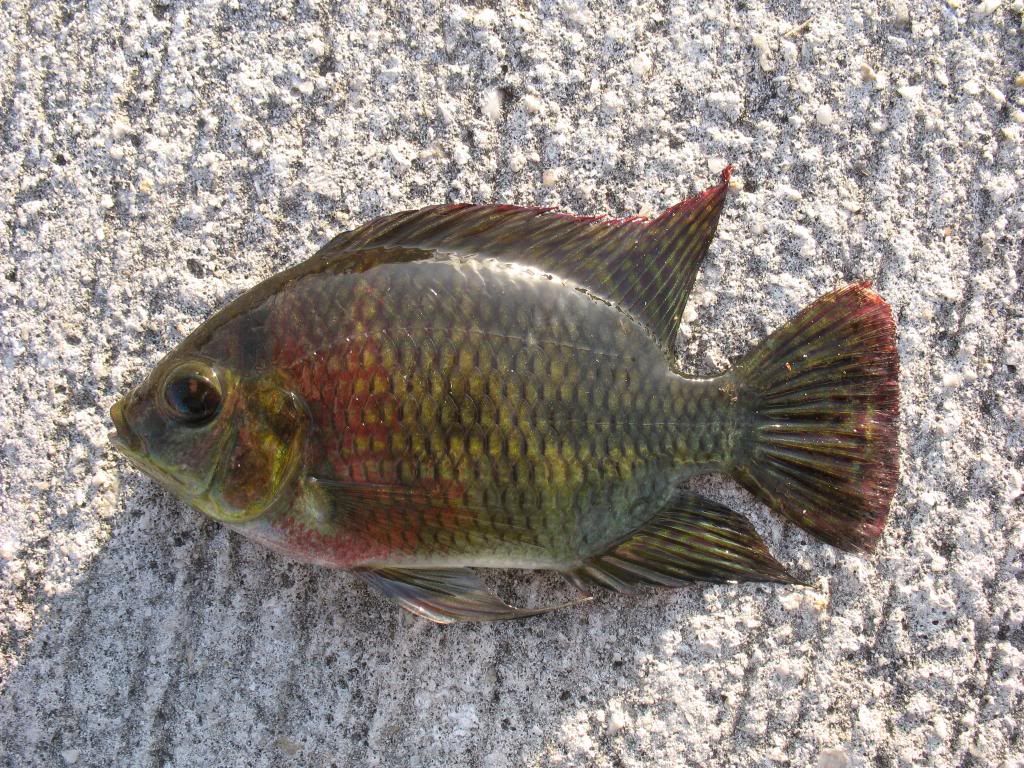
While I was catching more Spotted Tilapia to be used as bait, a Butterfly Peacock appeared out of nowhere to scattered the school. Unfortunately, the Butterfly Peacock, nor the Cobra Snakehead, came around to take our live bait.
We were having trouble finding Yellow Belly Cichlid. I stepped back for a second to analyze the situation, then decided to search the rock crevices lining the shore. My worm was immediately grabbed by a Yellow Belly Cichlid!
Yellow Belly Cichlid (Cichlasoma salvini) – new species #4
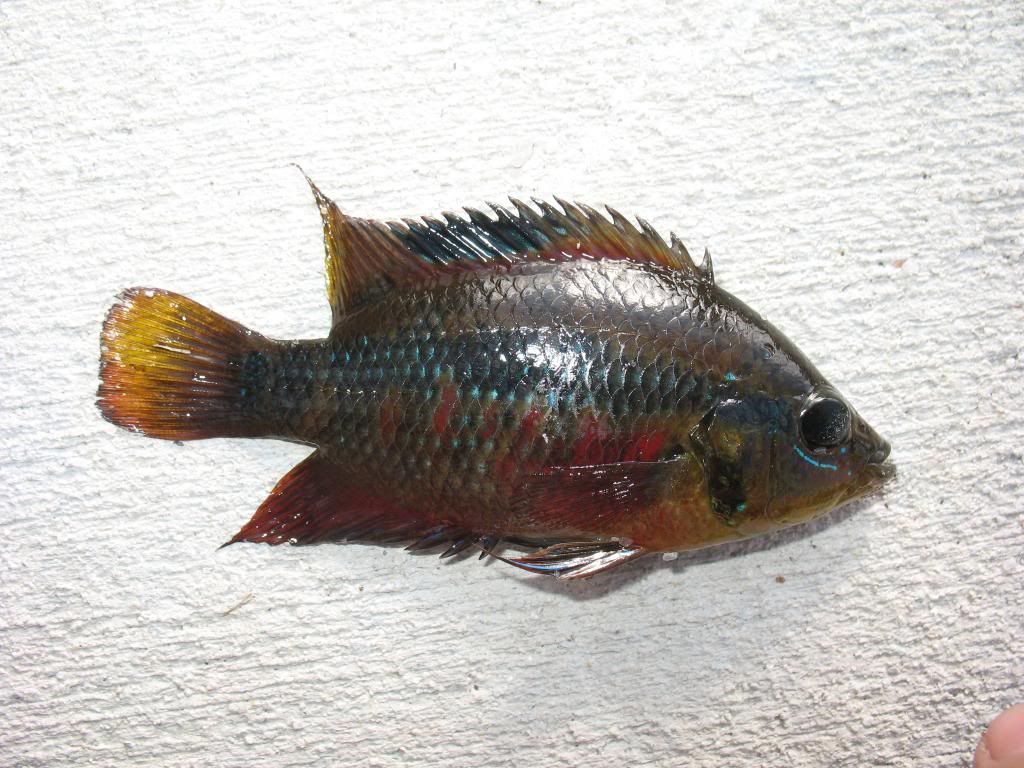
My thought was that with predators like Largemouth Bass, Peacock Bass and Cobra Snakehead swimming around, these small cichlids would not be caught hanging out in the open. It was great to figure out their hiding places and we caught many of them very quickly. Michael and I also caught some Mayan Cichlids, new to Michael, but I’ve caught them before.
After checking off our target species at this spot, we headed to a set of urban ponds connected by canals. Our major target here was the Jaguar Guapote. On arrival, we caught a few small Yellow Belly Cichlid to use as bait. It wasn’t long when Michael saw a dark fish refused his live cichlid. I tried the spot again with another live cichlid. As the cichlid swam under a culvert out of sight, my line went tight and I set the hook on a decent size fish. There was a flash of violet and I knew it was the Jaguar Guapote! We were not sure why it had refused Michael’s cichlid but taken mine. I thought that perhaps the fish had seen Michael and refused the bait, while I freelined the cichlid so it would swim under the culvert so it would be out of sight.
Jaguar Guapote (Parachromis managuensis) – new species #5
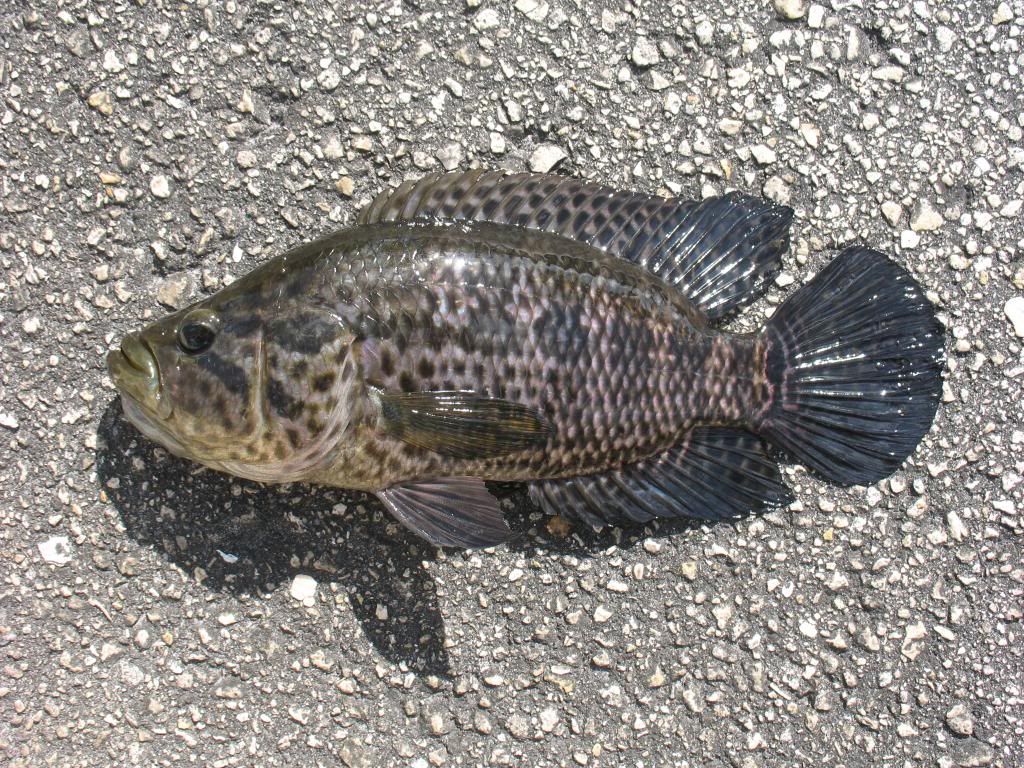
That was all the Jaguar Guapote we caught this day. Michael said he saw a couple more, and I might have seen another one, but the cold weather we experienced for the last couple of days must have turned these tropical exotic species into inactive mode. They simply didn’t want to play. We knew fishing was hard when Largemouth Bass were refusing to bite a lively cichlid!
We had to constantly watch where we step since any shoreline grass could hide a Water Moccasin. We got a little scare when this snake crept up on us, but luckily it was just a non-poisonous Brown Water Snake.
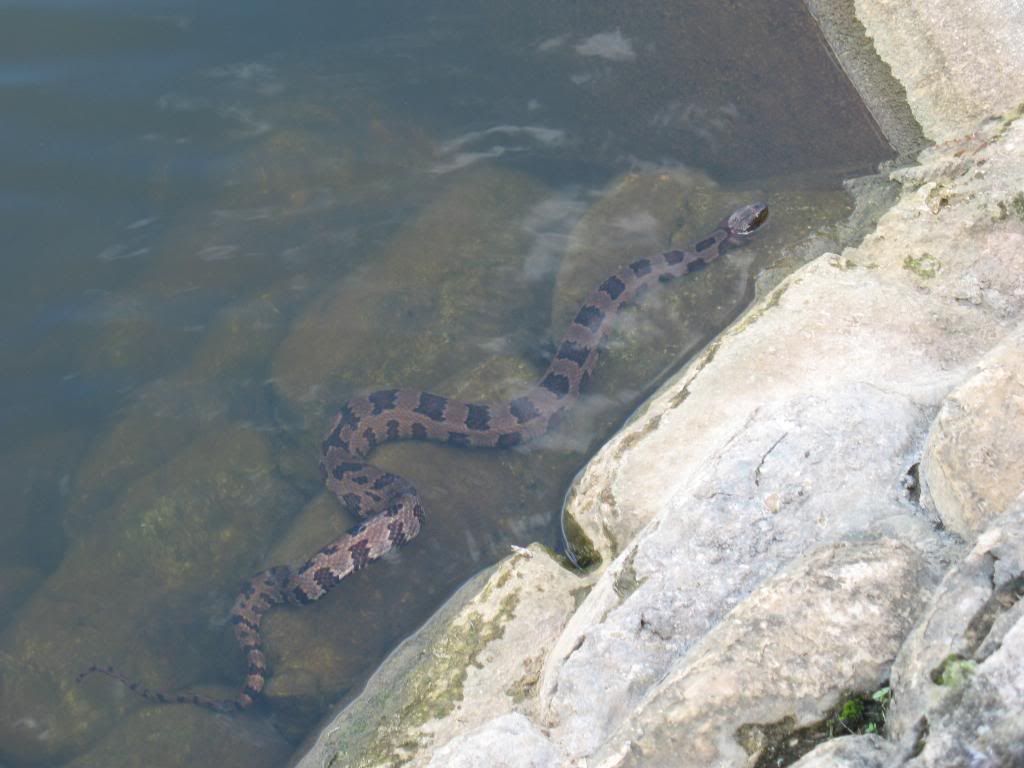
Aside from the cichlid and Largemouth Bass, there were a large number of Grass Carp in the ponds, as well as a small school of mullet plus a wayward Common Snook! It was quite the sight to see a 5-6lb snook swimming in this pond. There were a large number of plecos that ignored all our offerings, but we found a Brown Bullhead while deadsticking a worm. This southern population of the Brown Bullhead has very cool mottled marking that almost look like a camo pattern.
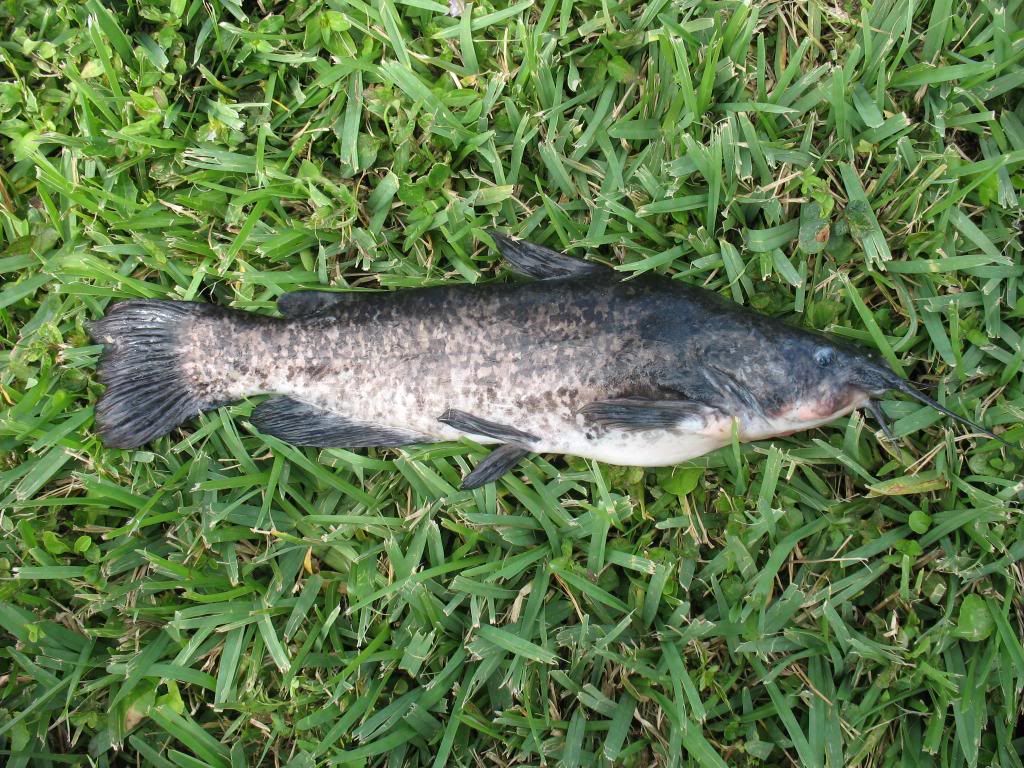
After fishing at this location for another few hours, we decided to return to Coral Springs to try fishing the canals in the area for Cobra Snakehead. Since the water was cold, late afternoon gave us the best possible chance to find active fish. The water must have been too cold. We did not see any snakeheads nor received any hits. I had one hit that might just had been a Largemouth Bass. We were fishing soft plastic frogs trying for a topwater bite. After searching 2 canals for nada, we ran out of daylight.
We had to return to my uncle’s house by 5pm anyways since we were meeting with my mom’s older sister for dinner that night.
Here’s my family and my sister’s boyfriend.
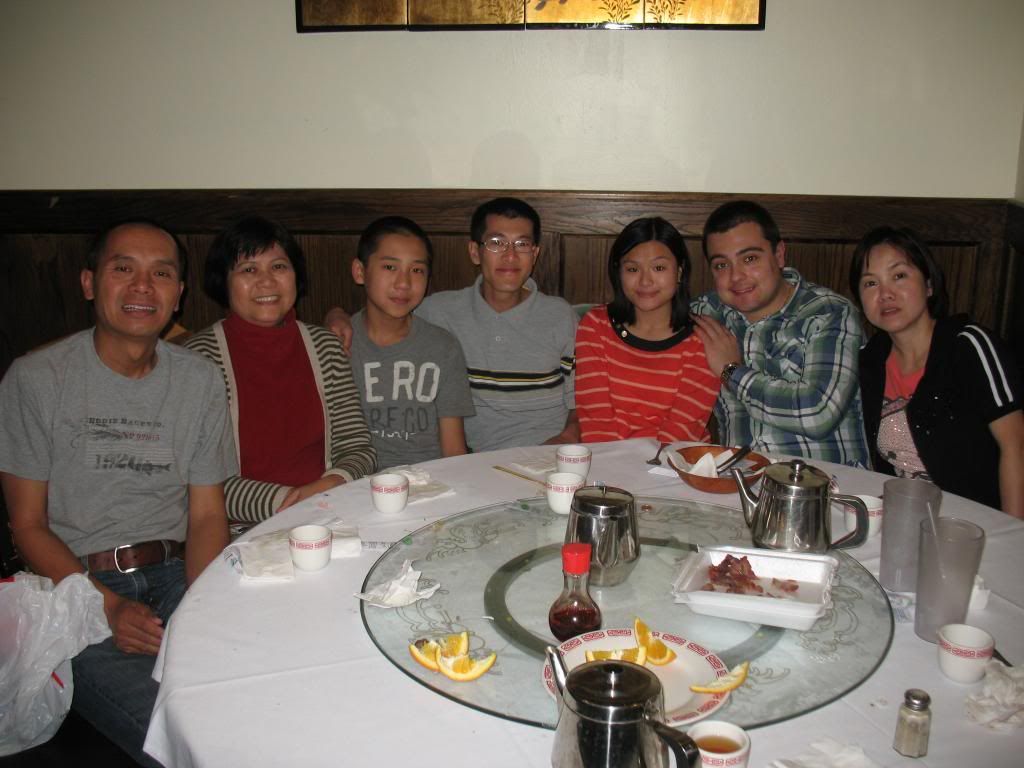
Jan 1, 2013
To be honest, fishing was very slow by my expectation. On my trip to Florida in April 2011, there were cichlids and Cobra Snakehead everywhere! I didn’t have much time to fish freshwater last time and was expecting to hammer the freshwater fish on this trip. After a couple of warmer days, we were hoping that fish would be active again and our luck could change.
We woke up earlier this day to reach our fishing location by 7am. Our first spot was a canal in Hammock area following a tip from our friend that we could find numerous willing Midas Cichlid and Mayan Cichlid. There could also be a small number of Jaguar Guapote and Butterfly Peacock. Unfortunately, we arrived to a creek devoid of any cichlids in sight. After 30 minutes, I finally saw one unwilling Butterfly Peacock and a school of large mullet. Having fished the area thoroughly both shallow and deep without so much as a tap, we decided to head to the Tamiami Canal for the rest of the day.
We really didn’t know how to proceed. The continued slow fishing really dampened our spirit. Despite fishing hard, we just can’t find many of our targets. We debated whether we should head deep into the Tamiami Canal or fish closer to civilization. In the end, we decided to go as deep as possible. I had a number of areas marked on the GPS to try. Along the way to our final destination, we decided to check out one of my spots for a quick look. Right beside the roadside ditch, we were greeted by wildlife…
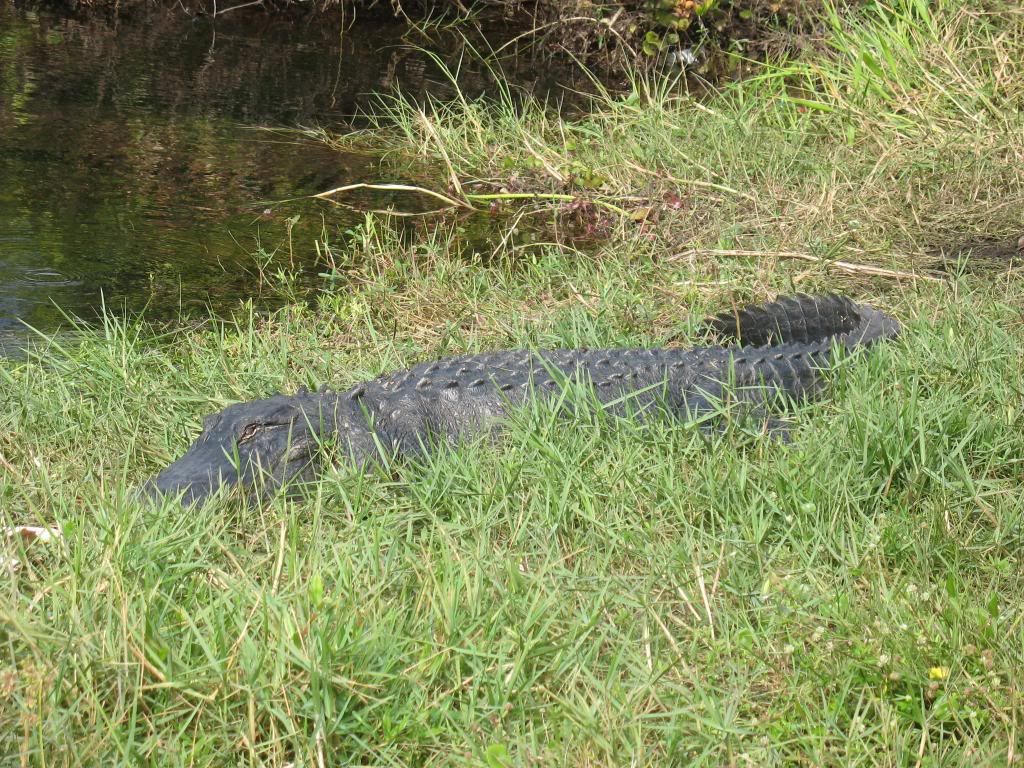
Despite the danger of a 7-8 foot alligator, we fished this spot within 15-20 feet of this reptile…since the ditch was literally boiling with Florida Gar!!! We first tried some small lures to see if they would hit artificial. However, we soon changed to pieces of cut sunfish to fish under a float. Once we started fishing cut sunfish, we were being picked up by gar almost every cast! We had to let the fish take the bait for a while before setting the treble hook, or else we often pull the bait out and the hook would not set. It took a few times to figure out how long we should wait, but we finally caught some Florida Gar!
Florida Gar (Lepisosteus platyrhincus) – new species #6
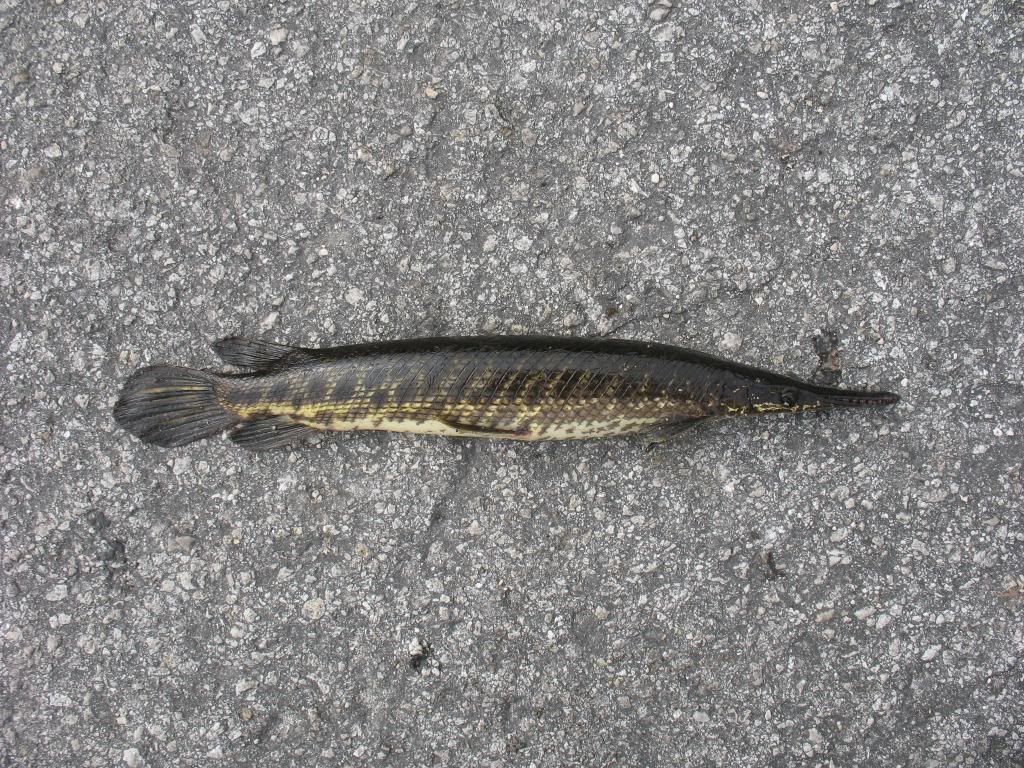
Michael and I both caught our lifer Florida Gar. We were hoping to find other native Florida species such as Warmouth Sunfish and Dollar Sunfish, as well as exotic species like Oscar and African Jewelfish. We were instead pestered by Bluegill Sunfish, Spotted Sunfish and Largemouth Bass. I even had a Bowfin on the line briefly before the hook came out. I tried to horse the fish quickly to shore since our gator friend was now taking notice of our fish on the line. It slowly approached us by creeping closer, then entered the water to sit about 2 feet from our PREVIOUS fishing spot. We both jumped back when we saw the gator enter into the water and swam toward us. Scary moment indeed!
I’ve caught a Spotted Sunfish on my previous trip but didn’t have a great photo. This one was just a little better…

When we found no other interesting species, and having the gator chased us off, we decided to fishing another spot.
As soon as we arrived in the new spot, Michael said he spooked an Oscar. That was quite optimistic…but we only and one other glimpse of the Oscar in the next 3 hours. This spot was filled with Largemouth Bass, some around the 3-4lb range, a very large number of Florida Gar, and a school of tilapia that did not want to bite. We fished the area well trying to find more Oscars or the other target fish mentioned above…but found none. I’m really not sure if it was the cold weather that turned off the bite, or if we were just not fishing the right area. African Jewelfish should be very prevalent in the Tamiami, but we had yet to even see one!
With very little action, I decided to play with the gar. At one point, I caught a bluegill sunfish that was deeply hooked. I tried to keep it in the water to keep it alive while I dig for my hemostat. While the sunfish was in the water, it attracted the notice of the Florida Gar and they started to chase the sunfish. They were following it intensely and I could “walk” the gar like you walk a puppy, haha! Finally, they started to hit the sunfish and grabbed on. The sunfish was a little too big to fit their mouths, so after grabbing on for a while, they would simply drop it. I retrieved the sunfish and cut it up for bait…and that was the beginning of a full hour action with the gar! I could almost get every gar in the area to grab the bait as long as I drift the chunk of sunfish on a free line in the currently to the gar. They would grab the chunk and drift back in the current. Most of the time, I just let them pull around a little and then yank hard to pull the bait out. A few times, I set the hook to fight the gar for a bit before the hook comes out. There was a bigger gar that I had wanted to land for a picture, but as I was lifting the gar out of the water and hand line it up the bridge, the line snapped.
When we had enough of the gar, we decided to fish another spot we passed by. Although the area looks very weedy and every bit the habitat for Oscars, we found no Oscar. Instead, we saw a large bass, caught a couple of bluegills, and hooked a 3-4lb Bowfin that snapped the line when we tried to land line it over the fence. Michael has a picture of the Bowfin on his camera.
We were parked at this place that sells gator tail sandwiches…I just had to try one. It was pretty darn good…MMM!
[
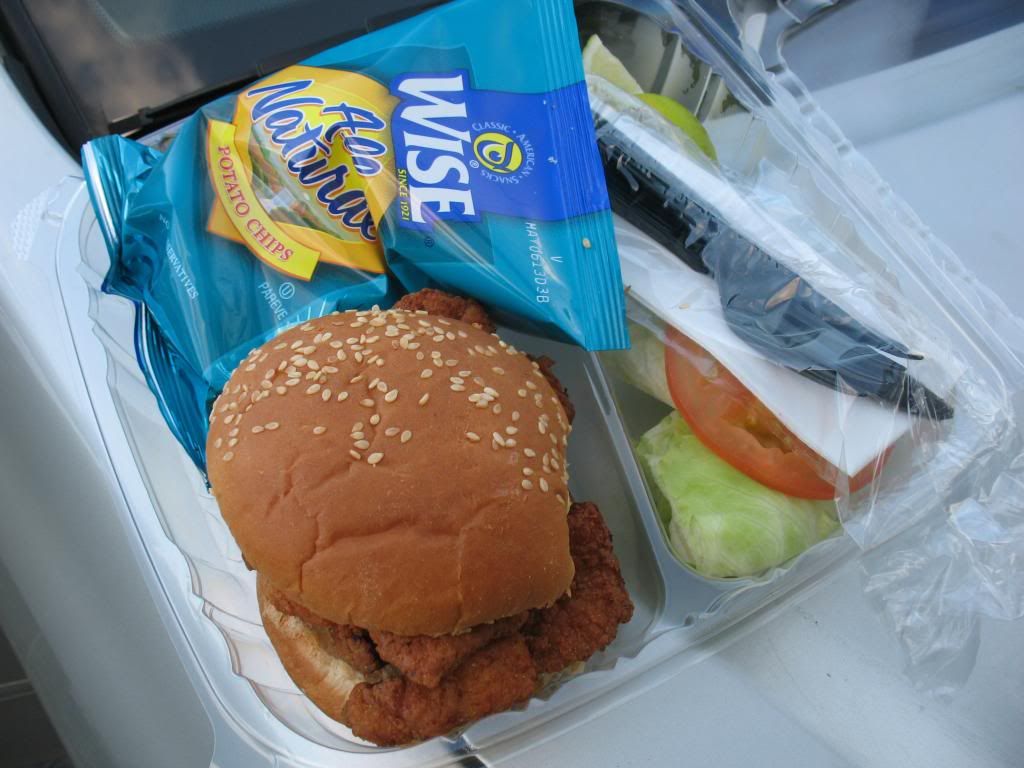
With about an hour left of daylight, we tried one last effort. We fished closed to the civilized end of the Tamiami before we had to return to my uncle’s house for dinner. We finally found something new with determination! Michael caught his first Butterfly Peacock and I caught my first Banded Cichlid!
Banded Cichlid (Heros severus) – new species #7
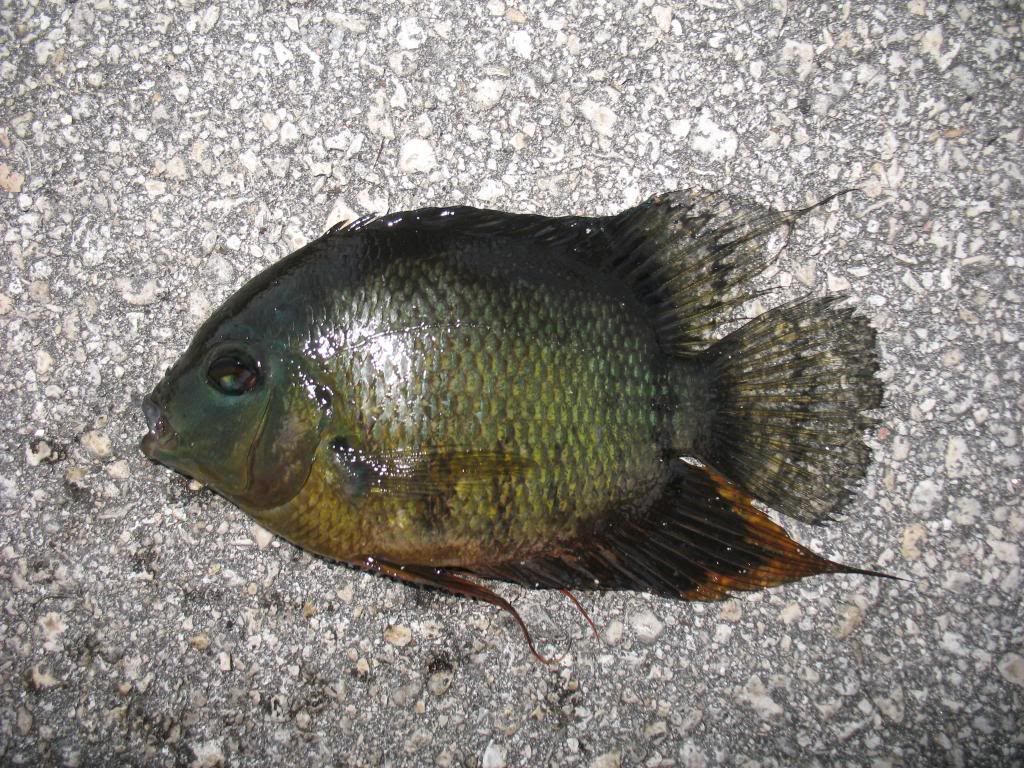
I also caught my third Redear Sunfish.
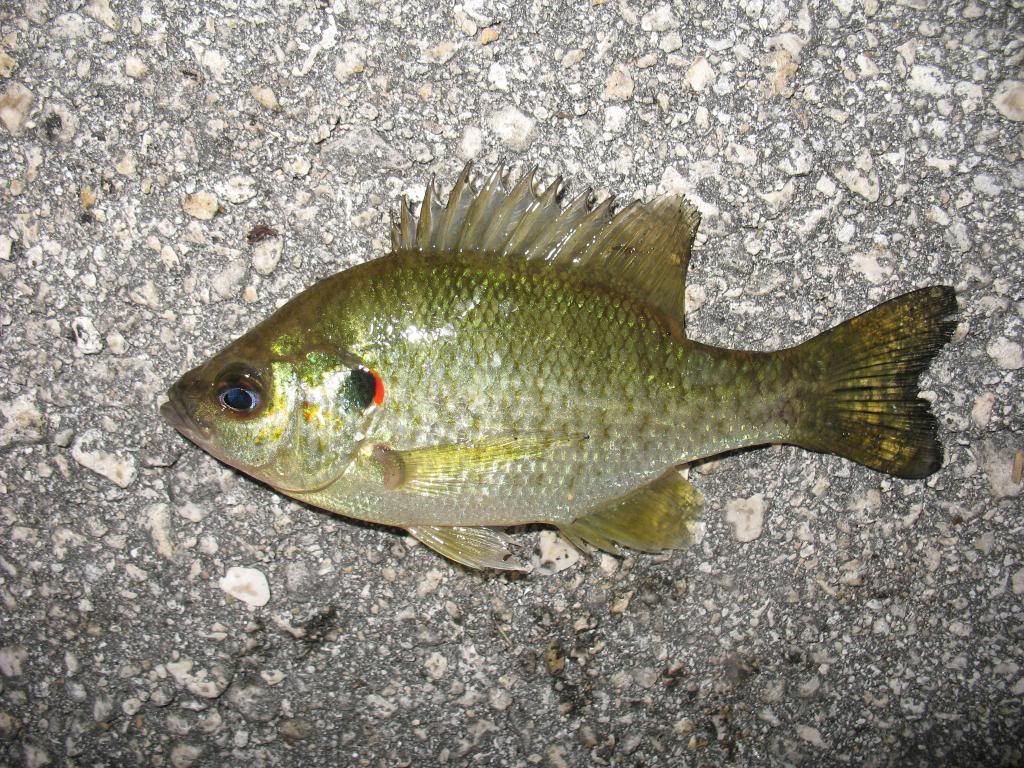
Jan 2, 2013
Our next phase of fishing will be taken in the Florida Keys. Before we head down to that saltwater paradise, I bought some big game gear from Bass Pro Shops so we can try our hands at shark fishing and perhaps a Goliath Grouper. We spent this morning picking up the gear before having lunch with my mom’s older sister and her husband. After lunch, Michael and I debated whether to try out a spot I’ve identified with a population of Midas Cichlid. To be honest, I was not very confident since the cold weather had all but foiled our freshwater species efforts. Since it was on the water to the Keys, we thought we would at least have a look-see.
We arrived to the canal at 2pm and immediately saw many Midas Cichlids! These fish would not bite worms. When the fish approach us standing my shore, an idea clicked! Ever since we saw the Grass Carp at the other location, we bought a couple loafs of bread just in case we needed it. I suggested that we should toss in some bread to see if the Midas would eat it. Bingo! We’re fishing with bread!
The fish were very picky though. They must have been heavily pressured since they could tell a piece of bread was on the hook. In the end, we had to fish the bread on a small hook with a tiny split shot under a float with a very long leader to allow the bread to sink naturally and into deep water. The fish were a little less wary if the bread sank into deeper water. After about 5 minutes of refining the presentation, I finally had a Midas made a mistake!
Midas Cichlid (Amphilophus citrinellus) – new species #8
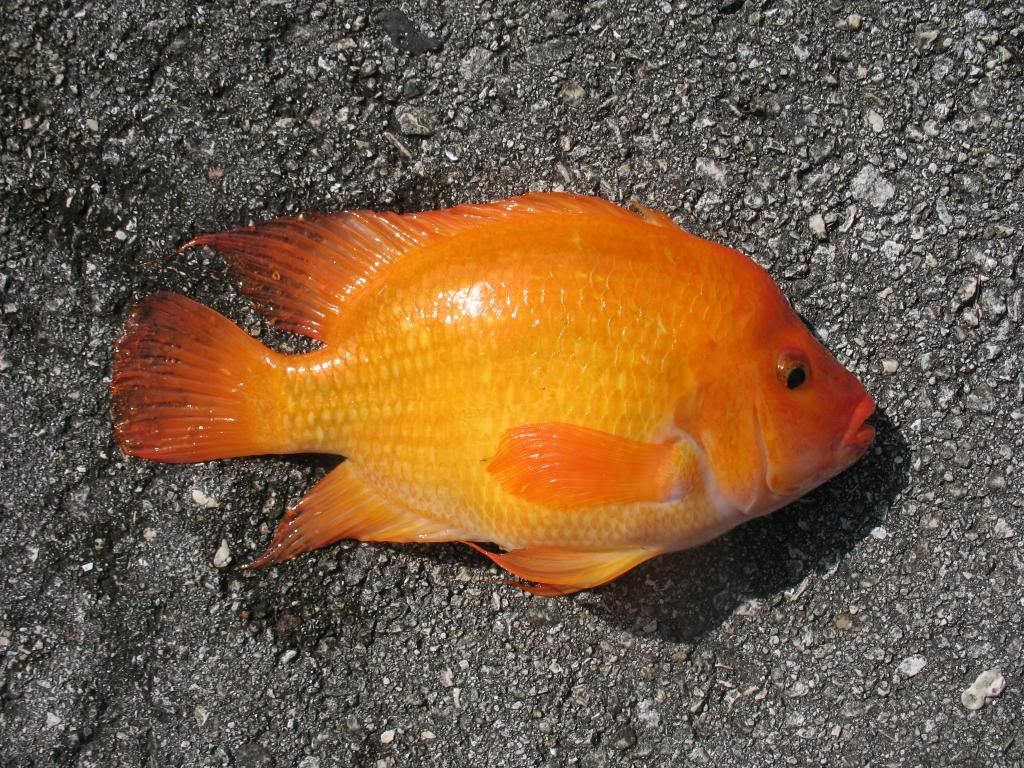
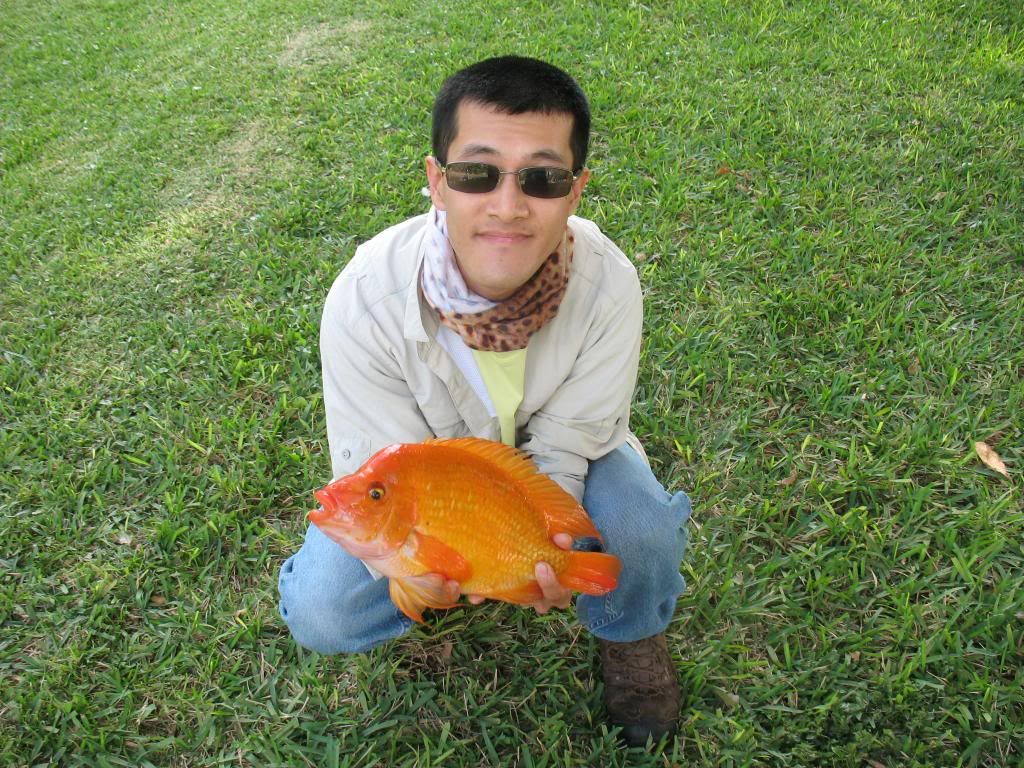
It took Michael considerably longer to catch his first Midas Cichlid since catch just one from the school spooked the other fish and they became even more wary. While waiting for Michael to catch his fish, I played with some Mayan Cichlids that were guarding their nests. They would nudge, bump or gently remove any offensive or intruding objects in their nests, but they would not pick it up enough to be hooked. While Michael was casting his bread bait, he got picked up twice while on the drop. These were big fish that immediately snapped his line. After he caught his first Midas Cichlid, he was crazy enough to tie on a large hair rig and put on a large chunk of bread. He was once again picked up on the drop about 30 minutes later and landed a 15lb Grass Carp. Seeing the opportunity, I tied on a hair rig too and used a good chunk of bread by wrapping the bread onto the hair rig loop. Michaal had 3 rods now fishing the hair rig with bread on bottom for Grass Carp, but they were not getting bit. So I started casting the bread bait and letting it sink naturally, and once the bread hit bottom, I would reel up halfway up the water column and allow the bread to fall again. I was always holding rod and fishing on a tight line. After about 10 casts, I got picked up. At first, it didn’t feel like a very big fish. The fish was coming up quite easily and I was guessing it was a small Grass Carp. When the fish surfaced and saw me, it put on the after burner! It took about 4 minutes of gentle pressure with the 8lb mono and a couple of tense moments with the net. Finally, Michael had it in the net! The fish kicked in the net and Michael took a tumble, bruising his leg and wet his feet, but he did keep his hands on the net and kept the fish in the bag!
Grass Carp (Ctenopharyngodon idella) – new species #9

I just had to take a few more pictures…
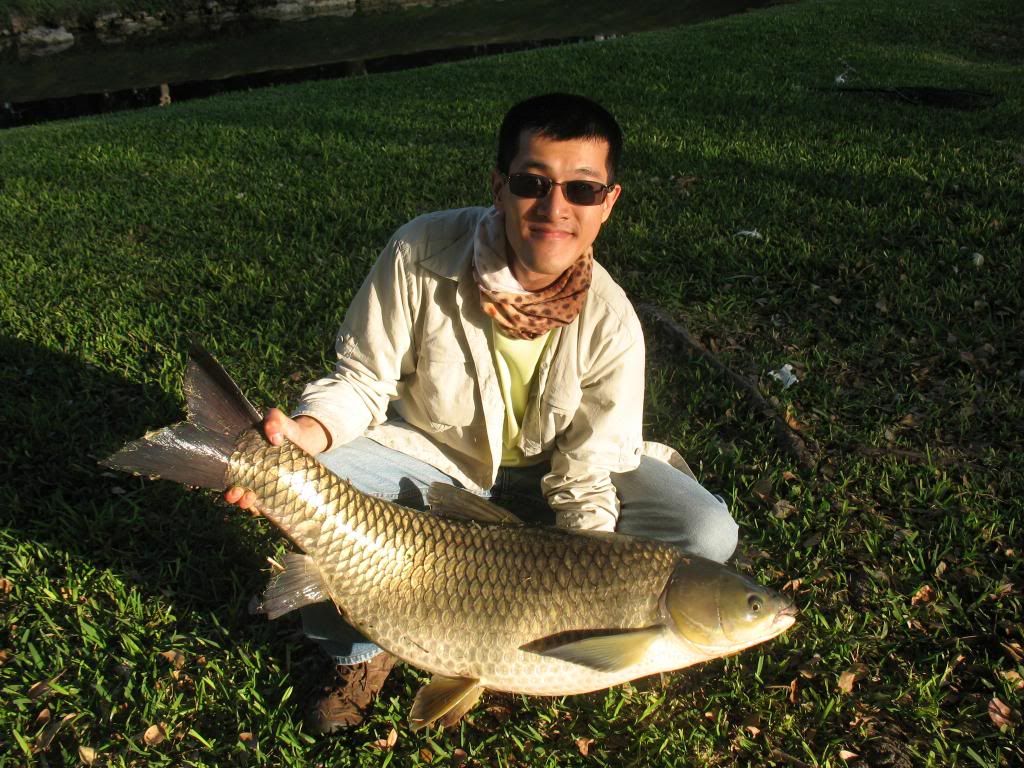
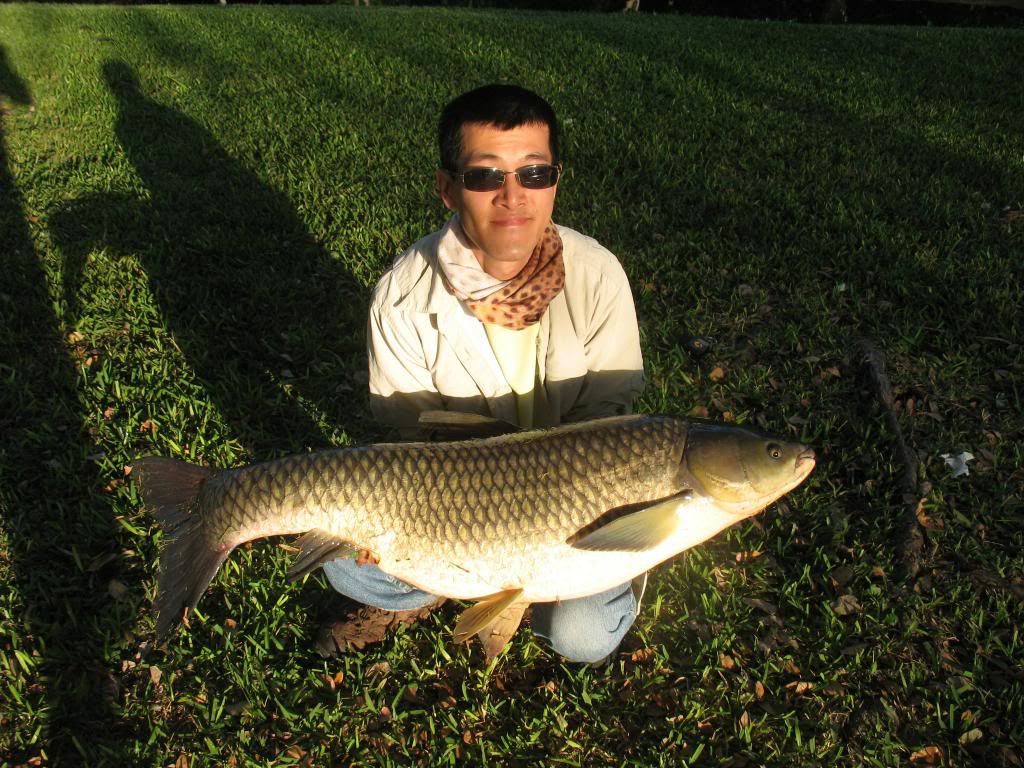
And the weight on Michael’s digital scale…30.5lbs!!!
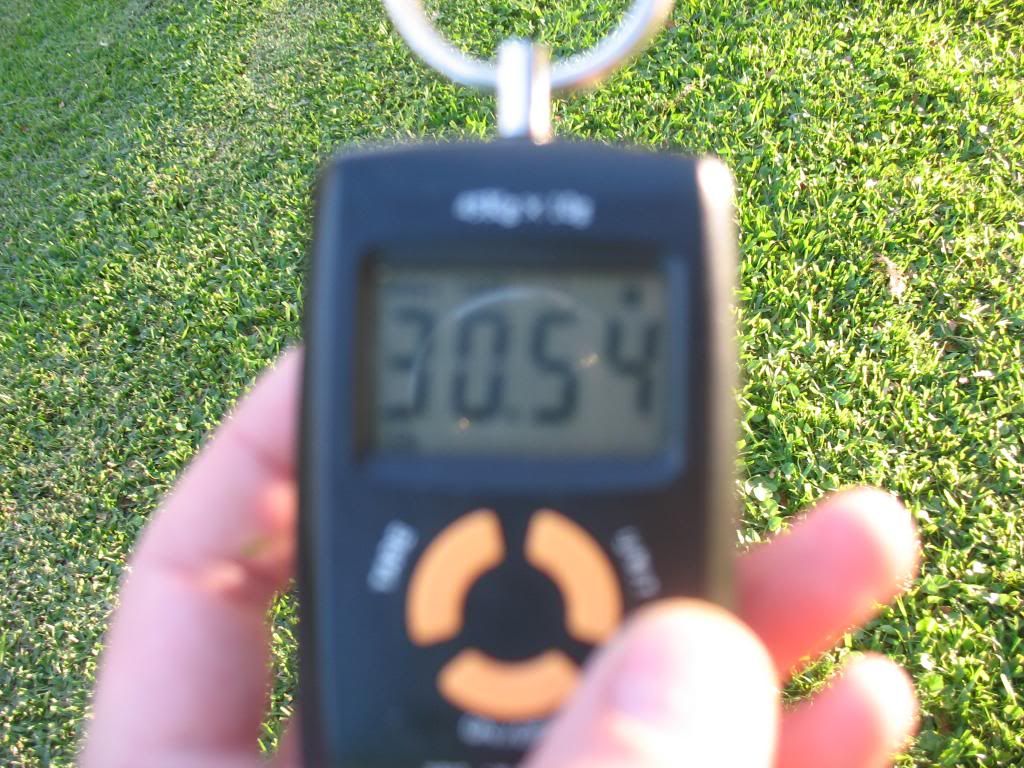
A new species, big or small, is magnificent on its own…but this just puts it over the top!!!
After catching the Grass Carp, I had to take a nap before the 2 hours drive to the Keys. Michael fished another 20 minutes without any bites. When I woke up, I walked to the washroom and saw a Butterfly Peacock on the walk back! I ran to grab my rod since I wanted to catch one for a good picture on my list (I’ve caught them in Hawaii previously). We had some pretty gross nightcrawler left, but that was all the bait we had with us. I tossed my worm at the Peacock, and out of nowhere came this Oscar! It swam quickly at my worm, but stopped short when it sniffed the funky smelly worm then turned away. Man, it’s a tough lesson to swallow…ALWAYS HAVE FRESH FRISKY WORMS!!!
Following the failure, I called it a day and we drove in the dark to the Keys. My sister and her boyfriend were already at the hotel room and we arrive just as they were getting ready to head to bed.